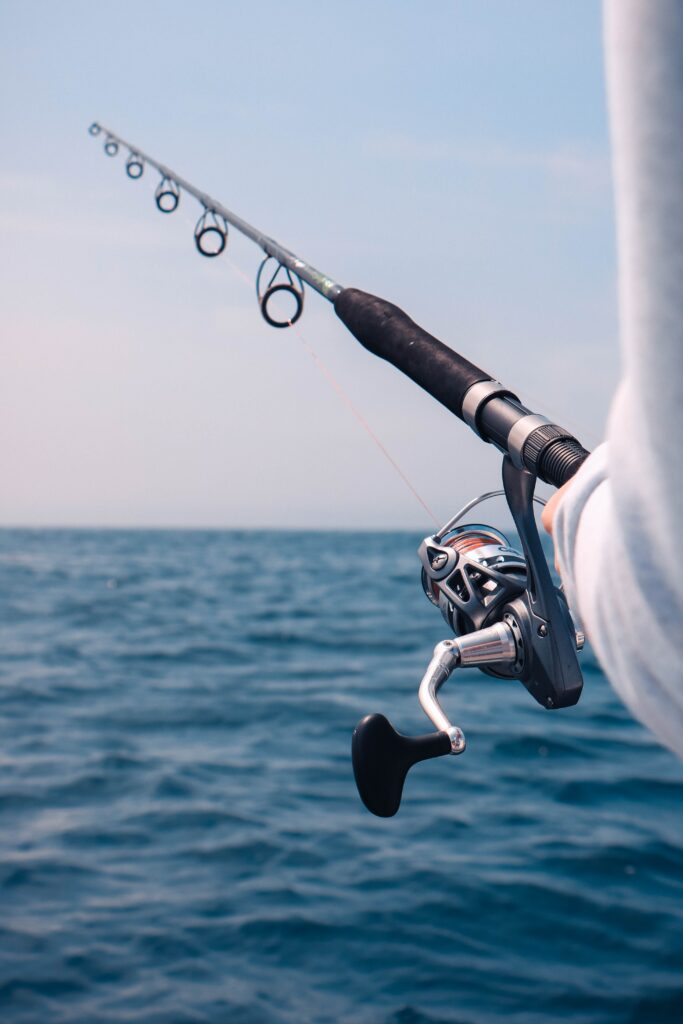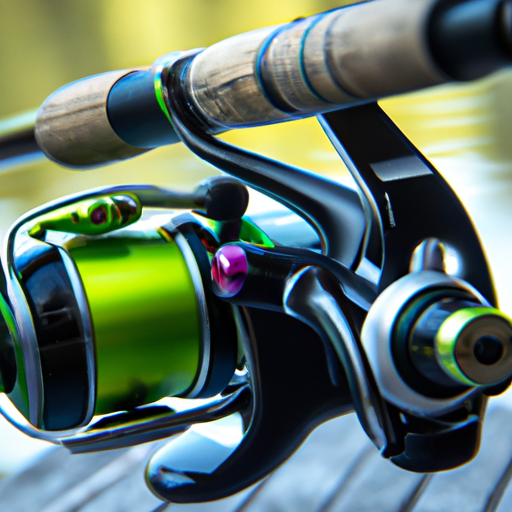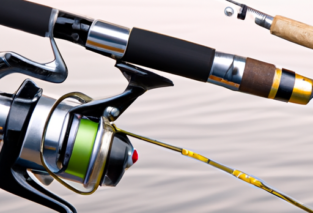Are you in search of the perfect fishing rod reel seat but feeling overwhelmed by the multitude of options available? Look no further! This article aims to simplify the process by providing you with valuable information on factors to consider when choosing the right fishing rod reel seat. Whether you’re a seasoned angler or a beginner, understanding these factors and following our recommendations will ensure that you make an informed decision and select the reel seat that best suits your needs. So, let’s dive in and explore the world of fishing rod reel seats together!

Factors to Consider
Types of Reel Seats
When choosing a fishing rod reel seat, one of the first factors to consider is the type of reel seat. There are two main types of reel seats: spinning reel seats and baitcasting reel seats.
Spinning reel seats are designed for spinning reels, which are commonly used in freshwater fishing. They feature a larger opening that allows the reel to sit on top of the rod. This design provides better balance and control, especially when casting lighter lures or baits.
On the other hand, baitcasting reel seats are designed for baitcasting reels, which are popular for targeting larger fish species or when heavier lures are used. Baitcasting reel seats have a narrower opening that allows the reel to be seated below the rod. This design enhances stability and control, making it easier to handle heavier line and reel in bigger fish.
Material
Another important factor to consider is the material of the reel seat. Reel seats are commonly made of either graphite or aluminum.
Graphite reel seats are lightweight and offer excellent sensitivity, making them a popular choice among anglers. They are also corrosion-resistant, which is advantageous when fishing in saltwater or brackish environments. However, graphite reel seats may not be as sturdy as their aluminum counterparts and can be prone to breakage if subjected to excessive force or abuse.
Aluminum reel seats, on the other hand, are known for their durability and strength. They are capable of withstanding heavy loads and rough handling, making them ideal for anglers who fish in challenging conditions or target larger fish. However, aluminum reel seats may not offer the same level of sensitivity as graphite reel seats.
Size and Style
The size and style of the reel seat are also important factors to consider when choosing the right one for your fishing rod. Reel seats come in various sizes, ranging from small to large, to accommodate different reel sizes. It is crucial to choose a reel seat that matches the size of your reel to ensure a secure fit and optimal performance.
Furthermore, reel seats come in different styles, including uplocking, downlocking, and sliding band. Uplocking reel seats have the locking mechanism located above the reel, providing additional security and preventing the reel from coming loose during fishing. Downlocking reel seats, on the other hand, have the locking mechanism located below the reel, allowing for a sleeker and more streamlined design. Sliding band reel seats use a sliding band to secure the reel in place and offer flexibility in positioning.
Personal Preference
Lastly, personal preference plays a significant role when choosing a fishing rod reel seat. Factors such as comfort, aesthetics, and familiarity can influence your decision. Some anglers may prefer a particular type of reel seat due to previous positive experiences or simply because they find it more comfortable to use. Additionally, some anglers may prioritize the overall look of their fishing rod and choose a reel seat that complements their preferred style or color scheme.
Fishing Rod Requirements
Fishing Technique
When selecting a fishing rod reel seat, it is essential to consider your fishing technique. Different fishing techniques require specific rod and reel combinations to achieve optimal performance.
For example, if you enjoy finesse fishing techniques such as drop shotting or shaky head fishing, you would benefit from a spinning rod with a corresponding spinning reel seat. The spinning reel seat offers better control and sensitivity, allowing you to detect subtle bites and make precise presentations.
On the other hand, if you prefer more aggressive techniques such as power fishing or flipping and pitching, a baitcasting rod with a baitcasting reel seat would be more suitable. The baitcasting reel seat provides the stability and control required when using heavier baits and fighting larger fish.
Fishing Rod Power
The power of the fishing rod is another crucial factor to consider when choosing a reel seat. Fishing rod power refers to the amount of force or resistance required to bend the rod. It is typically categorized as light, medium, medium-heavy, or heavy.
For lighter fishing applications such as finesse fishing or targeting smaller fish species, a rod with light to medium power is recommended. These rods are more flexible and sensitive, allowing for better lure control and detection of subtle strikes.
On the other hand, if you are targeting larger fish or using heavier lures, a rod with medium-heavy to heavy power would be more suitable. These rods offer increased backbone and lifting power, allowing you to handle bigger fish and cast heavier baits with ease.
Rod Length and Action
The length and action of the fishing rod also play a crucial role in reel seat selection. Rod length and action affect casting distance, accuracy, and overall rod performance.
In general, longer rods provide greater casting distance, especially when fishing from the shore or a boat. They also offer better line control, making them ideal for techniques that require long casts or extensive line management such as surf fishing or trolling.
Shorter rods, on the other hand, offer increased maneuverability and control. They are excellent choices for fishing in tight spaces or when precise presentations are necessary, such as fishing in thick cover or targeting specific structure.
The rod’s action refers to how much the rod bends and where it flexes along its length. Fast-action rods bend primarily at the tip, while medium-action rods bend in the middle, and slow-action rods bend through the entire length. The action of the rod affects its sensitivity, casting distance, and fish-fighting ability.
Rod Blank Diameter
Lastly, the rod blank diameter should also be considered when selecting a reel seat. The blank diameter refers to the thickness or diameter of the fishing rod’s main body.
Thicker rod blanks are generally more robust and capable of handling heavier loads and larger fish. They offer increased strength and durability, making them suitable for heavy-duty fishing applications or when targeting powerful fish species.
Thinner rod blanks, on the other hand, offer enhanced sensitivity and responsiveness. They are ideal for finesse fishing techniques or situations where a more delicate presentation is required.

Reel Compatibility
Reel Foot
When choosing a reel seat, it is essential to ensure compatibility with your chosen fishing reel. The reel foot is the part of the reel that attaches to the reel seat, and it must fit securely and snugly to ensure proper performance and prevent damage.
Different reel manufacturers may have slightly different reel foot designs or dimensions, so it is crucial to choose a reel seat that accommodates your specific reel brand and model.
Reel Size and Weight
The size and weight of the fishing reel should also be considered when selecting a reel seat. Different reel sizes and weights require corresponding reel seats to maintain proper balance and performance.
A reel that is too large or heavy for the reel seat may cause imbalance and affect casting accuracy and overall rod sensitivity. On the other hand, a reel that is too small or light for the reel seat may not fit securely, leading to potential damage or performance issues.
Reel Type
Different reel types, such as spinning reels, baitcasting reels, or fly fishing reels, require specific reel seats designed for their respective reel type.
Spinning reel seats are designed to accommodate spinning reels, which have a specific shape and attachment mechanism. Baitcasting reel seats are designed for baitcasting reels and feature a different attachment mechanism to ensure a secure fit. Fly fishing reel seats, on the other hand, are specifically designed to accommodate fly reels, which typically have a different structure and attachment method.
Ensuring the right compatibility between the reel seat and reel type is crucial for optimal performance and overall fishing experience.
Ergonomics and Comfort
Handle Design
The handle design of the fishing rod also contributes to overall ergonomics and comfort. A comfortable handle design can greatly enhance your fishing experience and reduce fatigue during long fishing sessions.
Different handle designs include full-length handles, split grip handles, and pistol grip handles. Full-length handles provide maximum control and leverage, making them suitable for techniques that require powerful hook sets or when fishing for larger fish. Split grip handles, on the other hand, feature a gap between the front and rear grip, reducing overall weight and providing a more lightweight and maneuverable feel. Pistol grip handles are characterized by a shorter rear grip and offer enhanced wrist comfort and control.
The choice of handle design ultimately depends on personal preference and the type of fishing technique you typically employ.
Grip Material
The grip material of the handle also plays a role in comfort and durability. Common grip materials include cork, EVA foam, and synthetic rubber.
Cork handles offer excellent sensitivity, comfort, and grip, making them a popular choice among many anglers. They are also durable and resistant to moisture and temperature changes.
EVA foam handles are known for their cushioning and shock absorption properties. They provide a firm and comfortable grip, even when wet, and are suitable for anglers who prefer a softer handle.
Synthetic rubber handles combine the advantages of both cork and EVA foam. They offer a good balance of comfort, grip, and durability and are often used on high-end fishing rods.
Reel Seat Position
The position of the reel seat on the fishing rod can also impact ergonomics and overall comfort. The reel seat should be positioned in a way that allows for a natural and comfortable grip, with the reel handle easily accessible to your dominant hand.
Some anglers prefer a forward reel seat position, which brings the reel closer to the rod’s butt section. This position provides better balance and control, especially when casting or fighting fish.
Others may prefer a rearward reel seat position, which allows for increased leverage and power when fighting larger or more stubborn fish.
Experimenting with different reel seat positions can help you determine the most comfortable and ergonomic setup for your fishing style.

Durability and Lifespan
Build Quality
The build quality of the reel seat is an important consideration for durability and overall lifespan. Reel seats should be constructed with high-quality materials and feature solid construction to withstand the rigors of fishing.
Check for any signs of weak or poorly connected components. Ensure that the reel seat is securely attached and that there are no loose parts or potential weak points that could lead to premature failure.
High-quality reel seats will not only provide durability but also enhance your overall fishing experience by providing a reliable and secure connection between the rod and reel.
Corrosion Resistance
Depending on your fishing environment and the type of fishing you do, corrosion resistance may be a crucial factor to consider when choosing a reel seat.
If you frequently fish in saltwater or brackish environments, where corrosion is more prevalent, opt for reel seats made of corrosion-resistant materials such as graphite or aluminum. These materials are known for their resistance to rust and saltwater damage, ensuring a longer lifespan for your fishing rod.
Regular maintenance and cleaning of your fishing rod, including the reel seat, will also help prevent corrosion and extend its overall lifespan.
Warranty
Considering the warranty offered by the reel seat manufacturer is also important. A reliable warranty demonstrates the manufacturer’s confidence in their product’s quality and durability.
Check the terms and conditions of the warranty, including any limitations or exclusions. Knowing that the manufacturer stands behind their product can provide peace of mind and assurance that you are investing in a high-quality reel seat.
Price Range
Budget Considerations
When choosing a reel seat, it is crucial to consider your budget. Reel seats come in a range of prices, from budget-friendly options to high-end models. Determining your budget beforehand will help you narrow down your options and make an informed decision.
While budget-friendly reel seats may offer good value for the price, they may not provide the same level of durability or features as more expensive options. However, it is possible to find reasonably priced reel seats that meet your requirements without breaking the bank.
Value for Money
It is essential to consider the overall value for money when selecting a reel seat. Assess the features, build quality, and reputation of the manufacturer to determine whether the reel seat offers good value for its price.
Researching customer reviews and seeking advice from experienced anglers can also give you valuable insights into the performance and lifespan of a particular reel seat.
Remember that value for money can vary depending on individual preferences and fishing needs. Consider what features and characteristics are most important to you and prioritize those when making your decision.

Recommendations
Reel Seat for Spinning Rods
For spinning rods, a popular and highly recommended reel seat is the Fuji DPS reel seat. Fuji is known for its high-quality fishing rod components, and the DPS reel seat lives up to that reputation.
The Fuji DPS reel seat features a sturdy graphite construction, providing excellent sensitivity and corrosion resistance. Its ergonomic design and secure locking mechanism ensure a comfortable and secure fit for your spinning reel. The Fuji DPS reel seat is available in various sizes to accommodate different reel dimensions.
Reel Seat for Baitcasting Rods
For baitcasting rods, the Fuji ACS reel seat is a top choice among many anglers. The ACS reel seat combines functionality and comfort, making it an excellent option for baitcasting enthusiasts.
The Fuji ACS reel seat features a lightweight aluminum construction, offering durability and strength for heavy-duty fishing applications. Its ergonomic design and adjustable hood allow for precise reel positioning and a secure fit. The ACS reel seat is available in different sizes and finishes to suit your preferences.
Reel Seat for Fly Fishing Rods
When it comes to fly fishing rods, the REC Recoil fly reel seat is highly recommended for its innovative design and high-performance characteristics.
The REC Recoil fly reel seat features a unique alloy construction that provides unparalleled resistance to corrosion, impact, and flex fatigue. Its coil spring design offers an excellent grip and prevents the reel from loosening during fishing, ensuring maximum control and stability. The REC Recoil fly reel seat is available in various sizes and finishes to match your fly fishing rod.
In conclusion, choosing the right fishing rod reel seat requires careful consideration of various factors. Factors such as types of reel seats, material, size and style, personal preference, fishing rod requirements, reel compatibility, ergonomics and comfort, durability and lifespan, price range, and recommendations should all be taken into account.
By understanding your fishing techniques, rod requirements, reel compatibility, ergonomic preferences, and budget, you can make an informed decision and select a reel seat that provides the perfect balance of performance, comfort, and durability for your fishing adventures.





